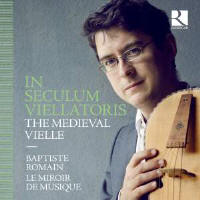Texte paru dans: / Appeared in: |
|
|
Outil de traduction ~ (Très approximatif) |
|
|
Reviewer: Barry
Brenesal
A few months back I reviewed
an album (Kapsberger’s Libro terzo d’intavolatura di chitarrone; Cremona
002-009) that attempted to separate (with only slight success) the
chittarone from the archlute and the tiorba. At various times and in various
places, the names were used interchangeably, as the instruments’ development
paths diverged and came together once more. Much the same holds true for the
medieval vielle, which is heard on this album—not only in its familiar
vielle presence, but also as a rubeba (with a soundboard made from goat
skin), and a six-stringed crwth. For further variety, we hear the instrument
in music transcribed over roughly 150 years, from the late 13th century to
the early 15th; as accompaniment in songs—including two of the three
surviving melodies by the Lespéronese troubadour Perdigon—and as a featured
lead in numerous estampies.
The character of the works is
sufficiently varied to sustain interest, differing in textures, tempo, and
fixed or flexible rhythms. Baptiste Romain’s Le Miroir de Musique consists
here of a harp, lute, mezzo, two sopranos, countertenor (Paulin Bündgen, one
of the best), four vielles, bagpipes, and percussion. Despite the ensemble’s
size, only two or three of these musicians are heard together on most
selections, granting these pieces a sense of intimacy. Various albums add
instruments to repetitions of a given estampie’s theme, creating a sense of
increased energy and power, with Mit ganczem Willen by Alla Francesca and
Alta an excellent example that comes to mind. (It’s on Armes Amours, Opus
111 30-221; deleted, yet well worth searching out.) But the dances heard
here at most add percussion after several thematic repeats, as occurs in La
uitime estampie Real. Continuity, rather than momentary excitement, is the
goal. The pair of voices in Soyés loyal a vo povoir, one of five vocal cuts (out of 16 selections in all) on the album, are lost within the ensemble, as well as being slightly washed out in tone. Elsewhere, all is well, with excellent balance between all members of this expert ensemble. In short, recommended, vocals aside. | |
|
Support us financially by purchasing this disc from eiher one of these
suppliers. |
|
|
|
|
|
Cliquez l'un ou l'autre
bouton pour découvrir bien d'autres critiques de CD |
|




